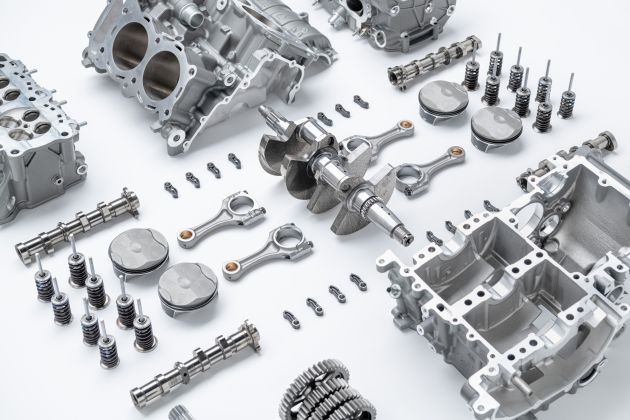Ducati V4 Granturismo engine – death of the desmo?
Ahead of the public launch of the 2021 Ducati V4 Multistrada, Ducati has released some technical details of the engine powering its latest adventure-tourer, the V4 Granturismo. What is most surprising, and at the same time not, is the new V-four mill from Borgo Panigale will use a conventional spring return system for the valve train instead of its traditional desmodromic valve actuation.
A little history lesson here, so pay attention. Back in the early days of engine design, we’re talking over a century ago, valve springs in engines tended to fail at high rpm, with the resultant catastrophic damage. This was because materials engineering and metallurgy had not reached the level of sophistication we have today, and it was expected valve springs would fail at engine speeds above 8,000 rpm.
Enter the desmodromic valve actuation system, mentioned in patents filed by one Gustav Mees in 1896 with the first recorded application in a 1910 marine engine built by Austin that produced 300 hp called “Irene I.” Using desmodromic valve actuation, the valve was mechanically opened and closed by physical actuation, rather than opening the valve using the physical movement of a cam and a spring returning the valve to a closed position.
Aside from eliminating the chance of spring failure in the valve train, desmodromic actuation also prevented valve “float” at high engine speeds. Valve float was a consequence of the valve spring rate unable to close the valve in time due to material resonance, necessitating the use of very high spring rates with the resultant mechanical drag and increased component wear in the engine.
The most famous application of desmodromic valve actuation occurred in 1955, when Mercedes-Benz built the W196 Formula 1 car of 1954 and in the road-going Mercedes-Benz 300 SLR sports car of 1955. In 1956 Ducati engineer Fabio Taglioni designed a desmodromic valve actuated engine for motorcycle use.
And the rest, as we say is history, with desmodromic actuation used in Ducati’s top-of-the-line racing engines since 1968. While other motorcycle manufacturers have made “conventional” valve train design with dual overhead cams work effectively, Ducati has seen considerable success with Desmo engines in competition and on the road.



However, desmodromic engines, notably as used in Ducati motorcycles, have a very strict inspection and maintenance schedule, leading to Ducati’s Desmo engines to be “expensive to maintain” and “finicky.” With the adoption of valve springs in the V4 Granturismo engine, Ducati intends to put an end to this perception for its… well… grand touring V-four engine.
In the V4 Granturismo, the engine itself weighs 66.7 kg, which, despite the addition of two cylinders, is actually 1.2 kg lighter than the Testastretta V-twin used in the current model Multistrada 1260. Displacing 1,158 cc, the V4 Granturismo mill is physically shorter and lower than the previous generation engine and only 20 mm wider.
The V4 Granturismo pumps out 170 hp at 10,500 rpm and 125 Nm of torque at 8,750 rpm fed by four 46 mm oval throttle bodies, all while being Euro5 compliant. The valve train is a hybrid of chain and gear drive with dual overhead camshafts and 4 valves per cylinder.
One feature of the V4 Granturismo is deactivation of the rear cylinder bank at idle, improving thermal comfort for the rider at traffic stops and slow road speeds. As anyone who has ridden a late model Ducati in Malaysian weather can attest, the amount of heat rising from the V-twin engine can be a little… toasty.
Maintenance intervals for the valve train have been increased, to every 60,000 km from the current 30,000. Ducati’s experience from racing at the highest level has also been incorporated in the V4 Granturismo, including a counter-rotating crankshaft with crankpins offset at 70 degrees and semi-dry sump lubrication.
Desmodromic engines are still being used by Ducati, notably in the MotoGP competition machine, the Desmosedici GP19 as well as the current crop of Panigale V4 super bikes along with the Diavel power cruiser and Multistrada 1260 adventure tourers in V-twin form. The V4 Granturismo engine, and the motorcycle that houses it, the 2021 Ducati V4 Multistrada, will be unveiled to the public on November 4.

























The post Ducati V4 Granturismo engine – death of the desmo? appeared first on Paul Tan's Automotive News.
from Paul Tan's Automotive News
Read The Rest:paultan...



Post a Comment